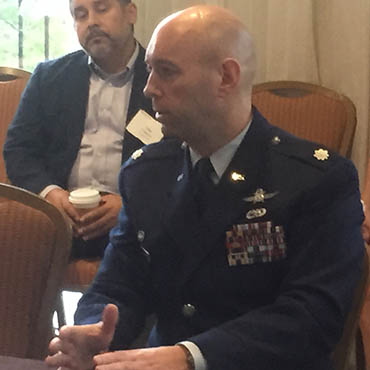At Joint Base San Antonio, Air Force lags on JRSS

Lt. Col. Timothy Kneeland, commander of Joint Base San Antonio’s 502nd Communications Squadron, says the base’s Air Force component is running behind on a key DOD IT modernization project.

Lt. Col. Timothy Kneeland, commander of JBSA's 502nd Communications Squadron, speaks April 7 at an FCW-sponsored panel discussion in San Antonio, Texas. (Image: Sean Lyngaas / FCW)
SAN ANTONIO, TEXAS -- Joint Base San Antonio, a sprawling complex shared by the Army and Air Force, has been a testing ground for a signature piece of the Defense Department's IT modernization plans. But the Air Force component of the base is lagging behind the Army in implementing the Joint Regional Security Stacks project and missing out on its security benefits, according to USAF Lt. Col. Timothy Kneeland, commander of the base's 502nd Communications Squadron.
The Air Force at Joint Base San Antonio "has not moved as aggressively to utilize the JRSS and all the capabilities within it" as the Army has, he told FCW. "That's something I seek to do," he added, because the stacks will enable interoperability at the base.
The 502nd Communications Squadron is charged with facilitating communication across the constellation of facilities that make up Joint Base San Antonio. The squadron serves 84,000 customers annually, according to Kneeland.
The JRSS are a collection of servers, switches and software tools meant to give DOD network operators a clearer view of network traffic. By sending that traffic to the cloud for analysis, the stacks can help operators quickly respond to network threats by, for example, opening certain ports or blocking a given IP address.
DOD CIO Terry Halvorsen has touted the stacks as the "cornerstone" of a larger department-wide initiative known as the Joint Information Environment, which seeks to standardize and consolidate IT networks for better security. A test of JRSS last year revealed a solid architecture and showed that "we had the capacity size right [but] we needed to do some fine tuning of the software sets and tools," Halvorsen told reporters in December.
JRSS is being deployed at more than 20 military sites around the world. Installation is complete in Europe, and the stacks reached "initial operating capability" at Joint Base San Antonio in September. According to Kneeland, however, the Air Force is flowing traffic only through the outer boundary of the stack.
Kneeland's goal is to run network traffic through each layer of the stack and fully leverage the analytics and security features that are possible through JRSS. The focus so far has been on "making sure that the links are all in place, but not actually utilizing the capabilities that are there," he said. "When that happens, I'll be able to then reroute traffic [to] the other installations."
The Air Force at Joint Base San Antonio was set to begin leveraging JRSS's security features in February, but their activation has been delayed, perhaps until July, according to Kneeland. A spokesperson for the Air Force's 26th Network Operations Squadron, which is helping implement JRSS at Joint Base San Antonio, could not be reached for comment.
When asked what he could do to speed implementation of the JRSS, Kneeland said, "Nothing. ... We're ready to roll on this end," and added that he planned to talk to DOD officials about the direction of JRSS implementation.
Kneeland said he understands that, with finite resources, the Pentagon had to prioritize implementation of JRSS in some places at the expense of others. "But being responsible for this area here in JBSA, I'd like to see us ... completely utilize JRSS," he said, "because I think there's great benefit in it."
Kneeland's goal of interoperability remains elusive, however. Some 1,000 Air Force personnel at JBSA Fort Sam Houston, for example, are forced to use an Army network because the Air Force network is unavailable to them. Having full access to the Air Force network would enable the personnel at Fort Sam Houston to talk to their colleagues at other JBSA facilities to work on records management and storage area networks, he added.
"You don't want to have to have a separate desktop environment for each place that you go," Kneeland said. "You want to be able to have a single one that you can be mobile and move around throughout."


